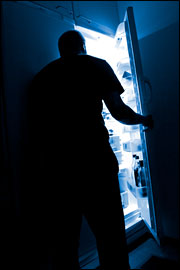Dear Umbra,
Are there any environmental advantages to the refrigerators with the freezer on the bottom and the fridge on the top?
Annette
Indianapolis, Ind.
Dearest Annette,
There are three fridge/freezer configurations: side by side, bottom freezer, and top freezer. In models with comparable storage volume, the least efficient is the side by side. Top and bottom models, on the other hand, are fairly close in their efficiency advantage, performing about 10 to 20 percent better than side-by-side models. Which is a fortunate discovery, since side-by-side models are hideous and have pathetic amounts of freezer storage. Speaking purely from a research perspective.

Inefficient fridge? Atone by eating in the dark.
Photo: iStockphoto.
All the special stuff that garnishes a fridge — the features manufacturers develop as part of the planned obsolescence scheme — add to the inefficiency of the appliance. Ice makers, external water-delivery spouts, even something I’d never heard of called an “anti-sweat heater” all add to the cost of operating your fridge. And when I say cost, you know I mean both the financial and ecological costs. It may seem that external ice delivery reduces energy use, because you don’t open the door to get ice, but the constant availability and manufacture of ice take up more energy.
While we’re on the fridge topic, let us graze over a few other salient shopping tips: It’s better to have one large fridge than two smaller fridges. It’s also better to have a smaller fridge than a larger fridge. Don’t buy a separate freezer if it’s only going to be full a month a year; freezers (and fridges) are most efficient when fullish. Use the Energy Star label — it’s your friend. Energy Star even has a daunting list of all the approved models, their capacity, their kWh, their features, and much, much more. Dork out!
Once you have your refrigerator in home, there are several things you can do to help with fridge efficiency (frifficiency?): clean the coils, keep the fridge away from heat sources (oven, Saint Bernard), and stick a thermometer inside to ensure you maintain the right temperature (35 to 38 degrees Fahrenheit).
Everything above is supported by official research. Unofficially, I do feel that bottom-freezer models make finding refrigerated food easier and faster, thus saving energy and your back — but that is the type of personal anecdote that leads to environmental confusion and hearsay. Egad.
Icily,
Umbra


